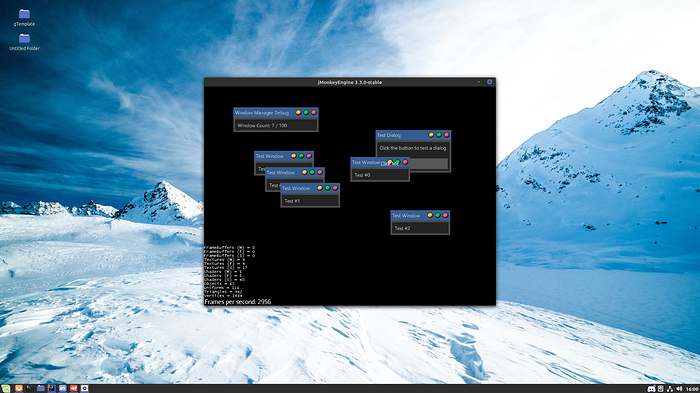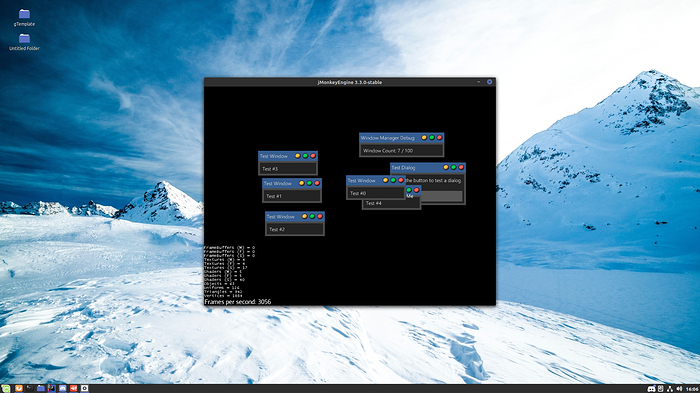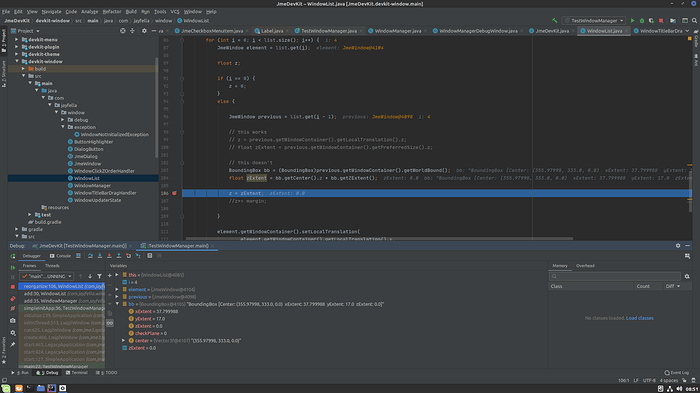Sure.
package com.jayfella.window;
import com.jayfella.window.exception.WindowNotInitializedException;
import com.jme3.math.Vector2f;
import com.jme3.math.Vector3f;
import com.simsilica.lemur.*;
import com.simsilica.lemur.component.IconComponent;
import com.simsilica.lemur.component.SpringGridLayout;
import com.simsilica.lemur.event.CursorEventControl;
import com.simsilica.lemur.event.CursorListener;
import com.simsilica.lemur.event.MouseEventControl;
import com.simsilica.lemur.style.ElementId;
import org.jetbrains.annotations.NotNull;
import java.util.UUID;
public class JmeWindow {
public static final String WINDOW_ID = "Window_ID";
public static final String ELEMENT_ID_TITLE_BAR = "window-title-bar";
public static final String ELEMENT_ID_TITLE_LABEL = "window-title-label";
public static final String ELEMENT_ID_WINDOW_CONTENT_OUTER = "window-content-outer";
public static final String ELEMENT_ID_WINDOW_CONTENT_INNER = "window-content-inner";
private static final String ELEMENT_ID_BUTTON_MINIMIZE = "window-button-minimize";
private static final String ELEMENT_ID_BUTTON_MAXIMIZE = "window-button-maximize";
private static final String ELEMENT_ID_BUTTON_CLOSE = "window-button-close";
private final Container windowContainer;
private final Container titleContainer;
private final Container contentParent;
private final Container contentContainer;
private final Label titleLabel;
private final Button minButton;
private final Button maxButton;
private final Button closeButton;
private CursorListener dragHandler;
private CursorListener clickHandler;
private final String id;
private WindowManager windowManager;
private final ButtonHighlighter minButtonHighlighter;
private final ButtonHighlighter maxButtonHighlighter;
private final ButtonHighlighter closeButtonHighlighter;
public JmeWindow() {
this(null, null);
}
public JmeWindow(String title) {
this(title, null);
}
public JmeWindow(String title, Panel content) {
id = UUID.randomUUID().toString();
windowContainer = new Container("null");
windowContainer.setUserData(WINDOW_ID, id);
// top bar (title, min, max, close)
titleContainer = windowContainer.addChild(
new Container(new SpringGridLayout(Axis.Y, Axis.X, FillMode.First, FillMode.First),
new ElementId(ELEMENT_ID_TITLE_BAR)));
// set the title if one has been given.
if (title == null) title = "";
titleLabel = titleContainer.addChild(new Label(title, new ElementId(ELEMENT_ID_TITLE_LABEL)), 0, 0);
minButton = titleContainer.addChild(new Button("", new ElementId(ELEMENT_ID_BUTTON_MINIMIZE)), 0, 1);
maxButton = titleContainer.addChild(new Button("", new ElementId(ELEMENT_ID_BUTTON_MAXIMIZE)), 0, 2);
closeButton = titleContainer.addChild(new Button("", new ElementId(ELEMENT_ID_BUTTON_CLOSE)), 0, 3);
contentParent = windowContainer.addChild(new Container(
new SpringGridLayout(Axis.Y, Axis.X, FillMode.First, FillMode.First),
new ElementId(ELEMENT_ID_WINDOW_CONTENT_OUTER)));
contentContainer = contentParent.addChild(new Container(
new SpringGridLayout(),
new ElementId(ELEMENT_ID_WINDOW_CONTENT_INNER)
));
if (content != null) {
contentContainer.addChild(content);
}
// button actions
minButton.addCommands(Button.ButtonAction.Click, source -> contentParent.removeFromParent());
maxButton.addCommands(Button.ButtonAction.Click, source -> windowContainer.addChild(contentParent));
closeButton.addCommands(Button.ButtonAction.Click, source -> {
if (windowClosing()) {
if (windowManager == null) {
throw new WindowNotInitializedException("You must add the window to the WindowManager!");
}
windowManager.remove(this);
}
});
// MouseEventControl.addListenersToSpatial(minButton, new ButtonHighlighter((IconComponent) minButton.getIcon()));
this.minButtonHighlighter = new ButtonHighlighter((IconComponent) minButton.getIcon());
this.maxButtonHighlighter = new ButtonHighlighter((IconComponent) maxButton.getIcon());
this.closeButtonHighlighter = new ButtonHighlighter((IconComponent) closeButton.getIcon());
}
private void addCursorEvents() {
CursorEventControl.addListenersToSpatial(titleContainer, dragHandler);
CursorEventControl.addListenersToSpatial(windowContainer, clickHandler);
CursorEventControl.addListenersToSpatial(titleContainer, clickHandler);
MouseEventControl.addListenersToSpatial(minButton, minButtonHighlighter);
MouseEventControl.addListenersToSpatial(maxButton, maxButtonHighlighter);
MouseEventControl.addListenersToSpatial(closeButton, closeButtonHighlighter);
}
protected void removeCursorEvents() {
CursorEventControl.removeListenersFromSpatial(titleContainer, dragHandler);
CursorEventControl.removeListenersFromSpatial(windowContainer, clickHandler);
CursorEventControl.removeListenersFromSpatial(titleContainer, clickHandler);
MouseEventControl.removeListenersFromSpatial(minButton, minButtonHighlighter);
MouseEventControl.removeListenersFromSpatial(maxButton, maxButtonHighlighter);
MouseEventControl.removeListenersFromSpatial(closeButton, closeButtonHighlighter);
}
Container getWindowContainer() {
return windowContainer;
}
void setWindowManager(WindowManager windowManager) {
this.windowManager = windowManager;
this.dragHandler = new WindowTitleBarDragHandler(true);
this.clickHandler = new WindowClickZOrderHandler(windowManager);
addCursorEvents();
// center it by default. Let the user set another location if they prefer.
// This way they won't get confused when a window doesn't appear.
centerOnScreen();
}
public WindowManager getWindowManager() {
if (windowManager == null) {
throw new WindowNotInitializedException("You must add the window to the WindowManager!");
}
return windowManager;
}
/**
* Gets the title of the window.
* @return the title of the window.
*/
@NotNull
String getTitle() {
return titleLabel.getText();
}
public void setTitle(String title) {
titleLabel.setText(title);
}
public void setContent(Panel content) {
contentContainer.clearChildren();
contentContainer.addChild(content);
}
/**
* Sets the location of the window.
*
* @param location the location of the window you wish to set.
*/
public void setLocation(Vector2f location) {
setLocation(location.x, location.y);
}
/**
* Sets the location of the window.
*
* @param x the x coordinate.
* @param y the y coordinate.
*/
public void setLocation(float x, float y) {
windowContainer.setLocalTranslation(x, y, windowContainer.getLocalTranslation().z);
}
/**
* Returns the location of the window.
*
* @return the location of the window.
*/
public @NotNull Vector2f getLocation() {
return new Vector2f(windowContainer.getLocalTranslation().x, windowContainer.getLocalTranslation().y);
}
/**
* Returns the calculated size of the window, or the size that has been set by the user.
* @return the calculated size of the window, or the size that has been set by the user.
*/
public @NotNull Vector3f getPreferredSize() {
return windowContainer.getPreferredSize();
}
/**
* Sets the preferred size of the window, overriding the calculated size.
* @param preferredSize the preferred size of the window.
*/
public void setPreferredSize(Vector3f preferredSize) {
windowContainer.setPreferredSize(preferredSize);
}
/**
* Brings this window in front of all other windows.
*/
void bringToFront() {
if (windowManager == null) {
throw new WindowNotInitializedException("You must add the window to the WindowManager!");
}
windowManager.bringToFront(this);
}
/**
* Puts this window behind every window.
*/
void sendToBack() {
if (windowManager == null) {
throw new WindowNotInitializedException("You must add the window to the WindowManager!");
}
windowManager.sendToBack(this);
}
/**
* This event is fired when a window is attempting to close, and can be cancelled by returning false.
*
* @return whether this close event is allowed to occur.
*/
public boolean windowClosing() {
removeCursorEvents();
return true;
}
public void centerOnScreen() {
if (windowManager == null) {
throw new WindowNotInitializedException("You must add the window to the WindowManager!");
}
setLocation(
windowManager.getApplication().getCamera().getWidth() * 0.5f - getPreferredSize().x * 0.5f,
windowManager.getApplication().getCamera().getHeight() * 0.5f + getPreferredSize().y * 0.5f
);
}
/**
* Provides an update loop.
* @param tpf time per frame.
*/
public void update(float tpf) {
}
}



